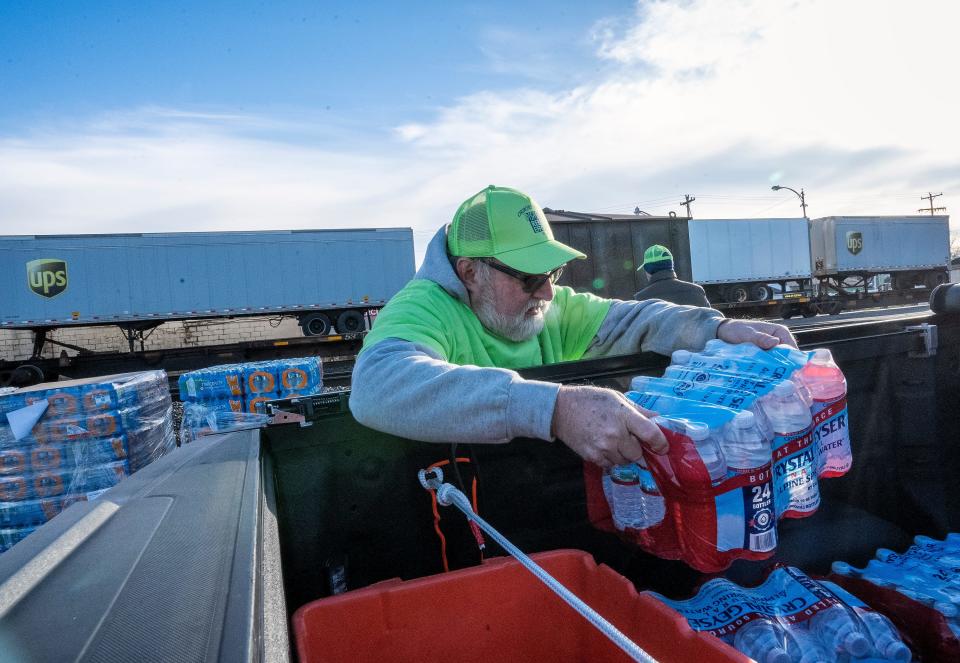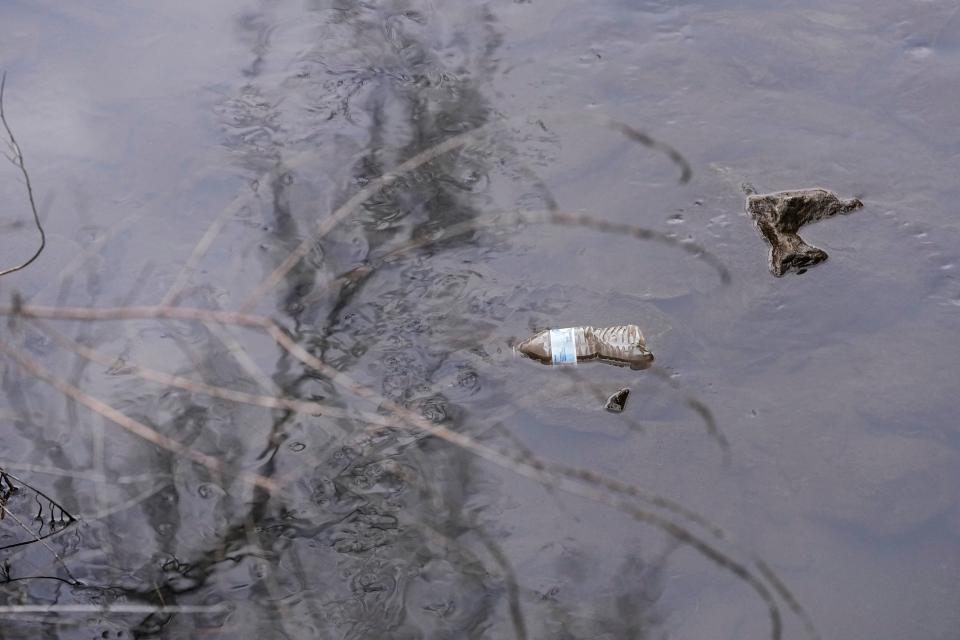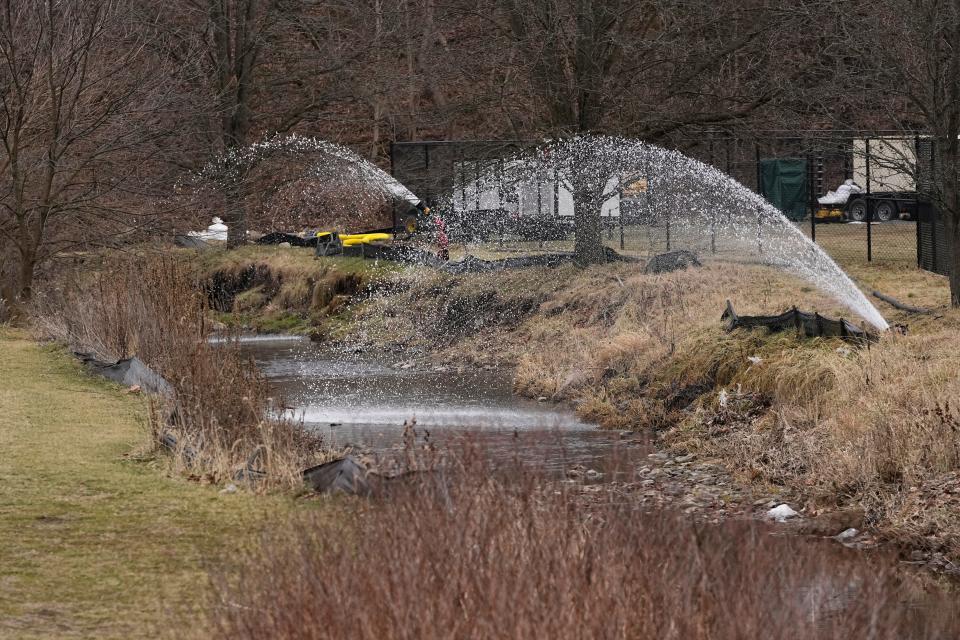Ohio officials say East Palestine's water is safe. But where's the full data?

When Ohio Gov. Mike DeWine announced that municipal water in East Palestine “showed no evidence of contamination" from the train derailment and chemical spill, he relied on data from a Norfolk Southern contractor instead of state or local officials.
Those results, from the Columbiana County General Health District, came in a few hours later. Officials say the tests confirmed data from the lab hired by the derailed train's owners − but the final report still hadn't been released more than a week later.
"If the results they are showing are correct, then fine, drink the tap water," said Nicole Karn, an Ohio State University professor who manages the undergraduate chemistry lab.
But, in her opinion, the results provided to the public so far don't show that conclusively.
Water samples taken by a Norfolk Southern contractor
When an accident like this occurs, it is "very common" for the responsible party to bring in private contractors to assist with "environmental data gathering and analysis," Ohio EPA spokesperson Heidi Griesmer said.
Norfolk Southern hired AECOM, a Dallas-based consulting firm, to collect water samples and Canton-based Eurofins TestAmerica Laboratories for testing.
AECOM collected water from five municipal wells and a sample of treated municipal water on Feb. 10. The preliminary results, which the governor relied upon, said, "there is no indication of risk to East Palestine Public Water customers.”
And Griesmer said she trusts those results. "Eurofins is a nationally accredited lab, which gives us confidence in the validity and accuracy of its results."
Coverage of the East Palestine train derailment is being provided for free. Subscribe today to support local journalism and access all of our content online.
Karn, however, said both the preliminary and final reports from Eurofins, released last weekend, show "concerning" details about how the water samples were collected.
First, the pH balance on five of the six samples in the preliminary report was wrong.
"There is a certain protocol that the EPA has deemed necessary for the analysis of these volatile organic compounds, and one of those parameters is that the water is acidic," Karn said.

Lowering the water's pH with acid helps keep certain chemicals like vinyl chloride from reverting back to a gas. If the solution isn't acidic enough, Kern said those gases could escape when the samples are opened and skew the results.
The second problem she saw was the air bubbles in some of the samples.
The bubbles cause the same problem as the pH being off in that they create a space for chemicals that naturally want to be gases to go. When the sample is opened, those gases dissipate, and the water can test cleaner than it actually is.
"It's very possible that we will end up getting the same results if sampling is done exactly as specified," Karn said. "But we don’t know that for sure."
Norfolk Southern, Ohio EPA say samples were collected properly
Both Ohio EPA and Norfolk Southern have disputed claims that these samples might not be accurate.
"We have confidence because they are following standardized U.S. EPA sample collection and analysis methods," Griesmer said.
And Norfolk Southern told HuffPost that the preliminary results contained erroneous information about the acidity of the samples, and it asked Eurofins to rerun the samples for the final report.
"The lab did not update the comments to note the re-testing and erroneously included the comments from the initial test," spokesman Connor Spielmaker wrote in an email to HuffPost.
But the final report still showed air bubbles and an incorrect pH in one of the samples.
Karn also took issue with the list of chemicals Norfolk Southern tested for.
Three chemicals listed as cargo on its train (diethylene glycol, ethylhexyl acrylate and ethylene glycol monobutyl ether) were not on the water testing reports. The reports didn't show testing for dioxins either.
What are vinyl chloride and isobutylene?More about the chemicals released in Ohio train derailment
These potentially carcinogenic compounds weren't on the train, but Karn said they could have been formed upon combustion of the vinyl chloride.
"More testing should be done," Karn said. "And that’s sort of the main thing: We need to make sure samples are collected properly, so we have more faith in the results we’re seeing."
Columbiana County's data still not public
Someone from the Columbiana County Health District or Ohio EPA accompanied the private collector when they went to the well and collected their own samples.
"We have received those results from Columbiana County, and they are consistent with the contractor’s results, both showing no contaminants associated with the derailment," Griesmer said.
But those results are not yet available to the public.
"We have not yet received finalized reports from our laboratory," Columbiana County Health District Program Manager Laura Fauss said. "When those are received, the residents will be notified, and then they will be posted on our website."

Future testing will be done by Ohio EPA and will take place in a different lab from the one chosen by Norfolk Southern.
"To be clear, this further testing is not because we believe there is a danger," said Dan Tierney, a spokesman for DeWine. "This is largely to allay the concerns of the people of East Palestine."
U.S. EPA has not been testing the water in East Palestine
The U.S. EPA is not testing the water in East Palestine, nor was data from the federal agency used by DeWine when he told the town's residents that their municipal water was safe to drink.
But the website created by Norfolk Southern after the derailment said "results from the US EPA’s continuous water testing of the East Palestine municipal well have shown no water quality concerns, and based on test results, Governor DeWine issued a press release stating the municipal water is safe to consume."
That statement is incorrect, according to both Tierney and Griesmer.
Contaminants found in Sulphur Run
The exception to the water testing results is Sulphur Run, a creek in East Palestine that Ohio EPA says was "grossly contaminated" by the train derailment.
The creek normally flows through a number of other waterways before emptying into the Ohio River, and the contaminated section has been blocked off while crews work to clean it.
"Environmental teams are treating the impacted portions of Sulphur Run with booms, aeration, and carbon filtration units," Norfolk Southern said in a statement. "Those teams are also working with stream experts to collect soil and groundwater samples to develop a comprehensive plan to address any contamination that remains in the stream banks and sediment."

So far, low levels of butyl acrylate and ethyl hexyl acrylate have been found in Leslie Run (where Sulphur Run first feeds into) but not in other waterways downstream.
"Sulphur Run was cut off from the water supply to prevent further contamination," Tierney said. But he understands why this makes people nervous.
Residents have seen dead fish and reported symptoms like headaches, dizziness, rashes and eye irritation. Lawsuits have already been filed and consumer advocate Erin Brockovich planned to hold a town hall meeting in East Palestine on Friday.
"People are hearing that and saying, 'Oh my God, there is no way this is safe. How could they have let us back,'" Tierney said.
That's one reason why Ohio EPA will continue to test the water.
"One thing government can do to reassure them is just constantly test and show we’re not seeing anything," he said.
The future in East Palestine
Chemicals can take time to work their way down through the soil and into underground wells like the ones that feed the municipal water supply in East Palestine.
"Our groundwater moves really slowly," said Linda Weavers, the co-director of the Ohio Water Resources Center at Ohio State University.
So, ongoing testing may be necessary.
Tierney told the USA TODAY Network Ohio Bureau that "all the experts told us there was just not enough time in the worst-case scenario for the chemicals to have traveled from the contamination site into the ground and to the water supply."
But residents of East Palestine and scientists have raised concerns about whether particulates that were spread during the controlled burn may seep into the village's water supply in the future.

Vinyl chloride a "highly flammable, potentially explosive gas" that can cause permanent damage the liver, skin and neurological system, according to the Centers for Disease Control and Prevention.
That's why Ohio decided to burn it off rather than wait to see if the derailed train cars would explode.
Burning it off created another hazardous chemical, though. It's called phosgene, and people have correctly noted its use as a chemical weapon in World War I.
The particles that landed on non-liquid surfaces "have a tendency to want to get back in the air," Weavers said, but chemicals that migrate down to the water table "can stick around for a long time."
State Democrats are calling for ongoing testing for the residents of East Palestine, and hearings are expected to start next week in the Ohio Senate.
"We need to be with the people of East Palestine for the long term because this is going to be long term," Rep. Lauren McNally, D-Youngstown, said.
Professor: Oily sheen on East Palestine creek behaving like vinyl chloride
So far, Ohio EPA says its tests have not detected vinyl chloride in waterways. What it has found is low levels of dibutyl phthalate, a chemical used to make plastics more flexible that can also be manufactured naturally by small organisms.
"Phthalate is a commonly occurring compound found in the environment," Griesmer said. "The detection at less than 0.8 pbb is a very low level and does not pose a health risk."
Still, Karn said she personally wouldn't drink the municipal tap water in East Palestine yet.
"It's just part of me being a little bit skeptical," she said. "But I would be drinking bottled water until I see more results."
Anna Staver is a reporter for the USA TODAY Network Ohio Bureau, which serves the Columbus Dispatch, Cincinnati Enquirer, Akron Beacon Journal and 18 other affiliated news organizations across Ohio.
This article originally appeared on Cincinnati Enquirer: What Ohio's governor knew when he declared East Palestine's water safe

